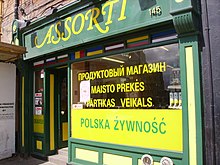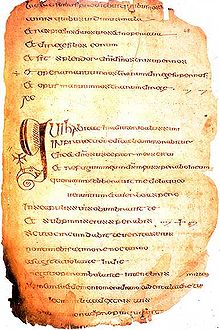Languages of Ireland
This article needs additional citations for verification. (September 2017) |
| Languages of Ireland | |
|---|---|
europa.eu ) | |
There are a number of languages used in
In the Republic of Ireland, under the Constitution of Ireland, both languages have official status, with Irish being the national and first official language.[3]
In Northern Ireland, English is the primary language for 95% of the population, and de facto official language, while Irish is recognised as an official language and Ulster Scots is recognised as a minority language under the Identity and Language (Northern Ireland) Act 2022.[4][5]
| Part of a series on the |
| Culture of Ireland |
|---|
 |
| History |
| People |
| Mythology and Folklore |
| Religion |
|
Art |
Languages
Prehistoric languages
The earliest linguistic records in Ireland are of
Modern languages
English
The 2002 census found that 103,000 British citizens were living in the Republic of Ireland, along with 11,300 from the US and 8,900 from Nigeria, all of whom would speak other dialects of English.[7] The 2006 census listed 165,000 people from the UK, and 22,000 from the US.[8] The 2016 census reported a decline in UK nationals to the 2002 level: 103,113.[9]
Irish
The original Primitive Irish was introduced by Celtic speakers. Primitive Irish gradually evolved into Old Irish, spoken between the 5th and the 10th centuries, and then into Middle Irish. Middle Irish was spoken in Ireland, Scotland, and the Isle of Man through the 12th century, when it began to evolve into modern Irish in Ireland, Scottish Gaelic in Scotland, and the Manx language in the Isle of Man. Today, Irish is recognized as the first official language of the Republic of Ireland and is officially recognized in the European Union. Communities that speak Irish as their first language, generally in sporadic regions on the island's west coast, are collectively called the Gaeltacht.
In the 2016 Irish census, 8,068 census forms were completed in Irish, and just under 74,000 of the total (1.7%) said they spoke it daily. The total number of people who answered 'yes' to being able to speak Irish to some extent in April 2016 was 1,761,420, 39.8 percent of respondents.[2]

Although the use of Irish in educational and broadcasting contexts has increased notably with the 600 plus Irish-language primary/secondary schools and creches [
Ulster Scots
Ulster Scots, sometimes called
Shelta
Shelta is a
Shelta is a secret language, with a refusal by the Travellers to share with non-travellers, named "Buffers".[14] When speaking Shelta in front of Buffers, Travellers will disguise the structure so as to make it seem like they aren't speaking Shelta at all.[15] There is fear that if outsiders know the entirety of the language, it will be used to bring further discrimination to the Traveller community.[16]
Sign languages
Irish Sign Language (ISL) is the sign language of most of Ireland. It has little relation to either spoken Irish or English, and is more closely related to French Sign Language (LSF).
Northern Ireland Sign Language is used in Northern Ireland, and is related to both ISL and BSL in various ways. ISL is also used in Northern Ireland.
Immigrant languages

With increased immigration into Ireland, there has been a substantial increase in the number of people speaking languages. The table below gives figures from the 2016 census of population usually resident and present in the state who speak a language other than English, Irish or a sign language at home.[17]
- Afro-Asiatic
- Arabic16,072
- Somali 1,495
- Austroasiatic (Mon–Khmer)
- Vietnamese 1,260
- Austronesian
- Dravidian
- Indo-European
- Baltic
- Lithuanian 35,362
- Latvian 14,197
- Germanic
- Indo-Iranian
- Romance
- French 54,948
- Spanish 32,405
- Romanian 36,683
- Portuguese 20,833
- Italian 14,505
- Slavic
- Other Indo-European
- Albanian 2,133
- Baltic
- Japonic
- Japanese 1,752
- Niger–Congo
- Sino-Tibetan
- Chinese 17,584
- Tai–Kadai
- Thai 2,135
- Turkic
- Turkish 2,047
- Uralic
- Other Northern European languages1,090
- Other Southern European languages857
- Other Eastern European languages1,137
- Other Asian languages4,465
- Other African languages4,342
- Other languages 23,451
Extinct languages
None of these languages were spoken by a majority of the population, but are of historical interest, giving loan words to Irish and Hiberno-English.

Latin
Norman language
Yola
Fingallian
Fingallian was similar to Yola but spoken in Fingal up until the mid-19th century.
Hiberno-Yiddish
Hiberno-Yiddish was spoken by Irish Jews until recently,[when?] when most switched to English. It was based on Lithuanian Yiddish.
Language education
Republic of Ireland
In primary schools, most pupils are taught to speak, read and write in
at second level.Students who did not immigrate to Ireland before the age of ten may receive an exemption from learning Irish. Pupils with learning difficulties can also seek exemption. A recent study has revealed that over half of those pupils who got exemption from studying Irish went on to study a Continental European language.[21] The following is a list of foreign languages taken at Leaving Certificate level in 2007, followed by the number as a percentage of all students taking Mathematics for comparison (mathematics is a mandatory subject).[22]
| Language | Higher Level | Ordinary Level | Total candidates | % of Maths |
|---|---|---|---|---|
| L1 English | 31,078 | 17,277 | 48,355 | 98.79% |
| L2 Irish | 13,831 | 25,662 | 44,018 | 89.94% |
| L2 French | 13,770 | 14,035 | 27,805 | 56.695% |
| L2 German | 4,554 | 2,985 | 7,539 | 15.372% |
| L2 Spanish | 1,533 | 1,127 | 2,660 | 5.424% |
| L2 Italian | 140 | 84 | 224 | 0.457% |
| Latin | 111 | 111 | 0.226% | |
| L2 Japanese | 90 | 90 | 0.184% | |
L2 Arabic
|
117 | 13 | 130 | 0.265% |
| L2 Russian | 181 | 181 | 0.369% | |
| L2 Latvian | 32 | 32 | 0.065% | |
| L2 Lithuanian | 61 | 61 | 0.125% | |
| L2 Dutch | 16 | 16 | 0.033% | |
| L2 Portuguese | 27 | 27 | 0.055% | |
| L2 Polish | 53 | 53 | 0.108% | |
| L2 Romanian | 25 | 25 | 0.051% |
Northern Ireland
The predominant language in the education system in Northern Ireland is English, with Irish-medium schools teaching exclusively in the Irish language. The ULTACH Trust coordinates the promotion of Irish in English-medium schools. In the GCSE and A Level qualification, Irish is the 3rd most chosen modern language in Northern Ireland, and in the top ten in the UK. Intakes in GCSE Irish and A Level Irish are increasing, and the usage of the language is also increasing.
References
- ^ "SPECIAL EUROBAROMETER 386 Europeans and their Languages" (PDF). Ec.europa.eu. Archived from the original (PDF) on 6 January 2016.
- ^ a b c "Irish Language and the Gaeltacht - CSO - Central Statistics Office". www.cso.ie. Retrieved 29 January 2023.
- ^ http://www.irishstatutebook.ie/eli/cons/en/html#part2 Irish Constitution. Article 8
- ^ "Identity and Language (Northern Ireland) Act 2022".
- ^ "Language and identity laws could spell significant change". BBC News. 11 December 2022.
- ^ D. Ó Corrain, 'A future for Irish placenames', in: A. Ó Maolfabhail, The placenames of Ireland in the third millennium, Ordnance Survey for the Place names Commission, Dublin (1992), p. 44.
- ^ "It's in the blood. The Citizenship referendum in Ireland". Threemonkeysonline.com. 1 June 2004. Retrieved 10 September 2017.
- ^ . 25 March 2009 https://web.archive.org/web/20090325005303/http://www.cso.ie/census/documents/Final%20Principal%20Demographic%20Results%202006.pdf. Archived from the original on 25 March 2009. Retrieved 10 September 2017.
{{cite web}}: Missing or empty|title=(help)CS1 maint: bot: original URL status unknown (link) - ^ "UK - CSO - Central Statistics Office".
- ^ "Broadcasting Act 2001" (PDF). 14 October 2009. Archived from the original (PDF) on 14 October 2009. Retrieved 10 September 2017.
- ^ "Official Languages Act 2003" (PDF). Oireachtas na hÉireann. 30 October 2003. Retrieved 8 June 2011.
- ^ "Aw Ae Oo—Scots in Scotland and Ulster" (PDF). Scots-online.org. Archived from the original (PDF) on 1 April 2017. Retrieved 10 September 2017.
- ISBN 978-90-272-5271-5.
- ISBN 978-90-272-5271-5.
- ISBN 978-90-272-5271-5.
- ISBN 0-85389-493-0.
- ^ "Population Usually Resident and Present in the State who Speak a Language other than English or Irish at Home 2011 to 2016 by Birthplace, Language Spoken, Age Group and CensusYear".
- ^ "The Parish of St Kevin, Harrington Street - Archdiocese of Dublin". Stkevinsdublin.ie. Retrieved 10 September 2017.
- ^ "The Latin Mass Society of Ireland » Mass Listings". Latinmassireland.com. Retrieved 10 September 2017.
- ^ "TEANGACHA SA CHURACLAM IAR-BHUNOIDEACHAIS : plécháipéis : Samhain 2003" (PDF). Ncca.ie. Archived from the original (PDF) on 25 October 2017. Retrieved 10 September 2017.
- ^ "Irish language opt-outs soar". Independent.ie. Retrieved 10 September 2017.
- ^ Results of Exams in 2007 Archived 19 November 2007 at the Wayback Machine Using mathematics as comparison, as its examination is near-universal at some level and had the largest number of candidates in 2007.
